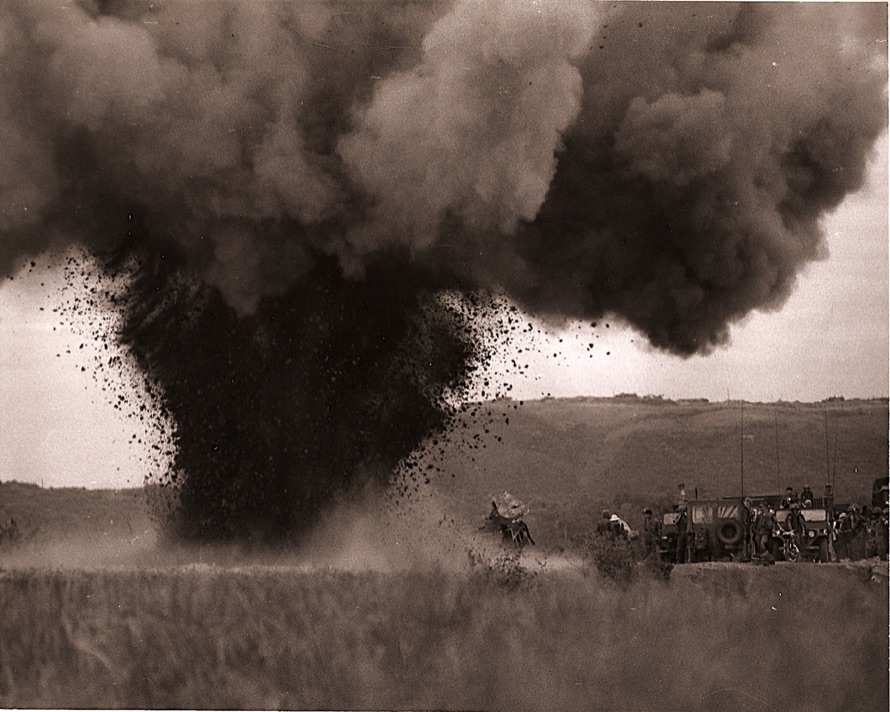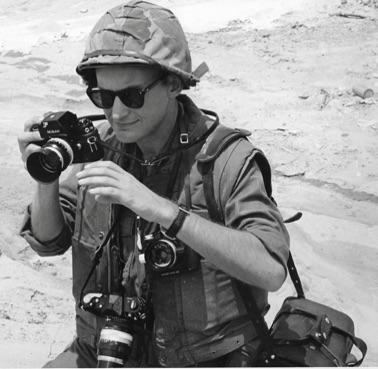
Just Another Day
in Vietman, 1967
This story appeared in Stars and Stipes,
June 19, 1967
By David H. Lyman, JO3 USNR, MCB-71
A sunny morning in June, 1967. It’s already turning hot as Stapleton and I left the gate to our base in Chu Lai. My EO buddy is driving a jeep, its rag top off, the windshield down, to take advantage of the breeze. We drove through the huge Chu Lai military enclave, exited through the perimeter, with a wave to the Marine guard, and joined a line of traffic already filling Highway One. We were heading south to Tam Ky so I could photograph our men from C Company building observations towers for the Army.
Trucks and civilian vehicles were heading in both direction down this narrow, lane-and-a-half dirt road. It was stop and go. It was a hot day and we were eating dust in the open jeep from the traffic ahead. We hung back little to let the dust settle. We drove out of the Chu Lai area into the flat green countryside. Rice fields on either side of the road, gave way to the occasional hamlets scattered along the way.
A few vehicles ahead of us was a Marine convoy, two six-byes were shepherding a large 5o,000 gallon JP5 tanker heading for an Army Huey camp near Quango Ngai.
Then it happened.
A tremendous explosion up ahead. Stapleton slammed on the breaks and pulled the jeep off the road. We grabbed our riles and dove into the rice patty. A road mine had gone off, blowing the lead six-by into the air. A mine explosion might be followed by an ambush—so we’d been taught in Camp Lajune.
“Get off the road and take cover.,” The Marine Sargent told us. “A road mine will stop traffic. A perfect time for the snipers to open up.”
Traffic stopped. The Marines in the truck behind the tanker ran forward, searching the rice patties along the roadside for an ambush. After a while, 15 minutes or so, people began milled about. No ambush. I walked forward, past the tanker, to the wrecked six-by—just a journalists, asking questions, finding what was happening.
The lead truck in the small convoy had hit a road mine, blowing off the rear tires, throwing the dump body and its occupants through the air. Then the gas tank on the truck let's go, engulfing it in flames. Two Marines ran past me to pull the still unconscious driver and shotgun to safety as the truck burned.
The dump body had held four Marines. Two were found a hundred feet from the road in a rice patty. They had mounted their last convoy.
All traffic on Highway One that morning was stopped, in both directions. We waited for an Army EOD (Explosive Ordinance Disposal) unit to arrived and sweep the road for additional mines.
The tanker crew, two young Army guys, were still shaking from the explosion as I walked by. They’d just lost two of their mates. They were out of the cab, leaning on the front bumper of their tanker, smoking—white as a sheet. I walked up to get their story. The tanker crew included the driver Lance Cpl. Burt Corbin, 20 years old, and Pfc. Don Patterson, his shotgun. Both were “short timers” with less than two weeks left before being shipped back home.
An Army EOD minesweeper with headphones approached waving his disk on a pole back and forth over the road. He came right up to us, asked us to step aside, and swept the road under the truck, between the tires. He paused, swept the same spot again, took off his earphones and called over another EOD. They conferred, got down on their knees and drew a circle with an X in the middle between the front tires. Then told us they needed the tanker moved back around 100 yards, along worth the rest of the traffic. This took an hour.
When the tanker was safely out of the way, the EOD men poked and prodded the marked spot on the road bed with their K-bars. They confirmed an unexploded mine. It had been directly under the front axel the tanker. The VC had place a series of these mines just off the crown of the dirt road, where normal traffic would miss them. When two vehicles met at that spot one would have to edge over and detonate the devise, catching two vehicles instead of just one. I was photographing the Army EOD unit as they placed a block of composition C on top of the mine, and told me to get the hell out of there. I walked off into a rice patty, on a raised foot path, a few hundred yards away, to where I could get a picture of what came next.
The Army EOD team cleared the area of personnel, lead the wires from the explosive back to a detonator, and instead of digging up the mine, they blew it up in place. I snapped the picture of the black mushroom cloud of dirt and dust, only to find a few seconds later, I had to crouch down, tuck my head into my collar as shrapnel, gravel and stones shower and down on my helmet and flack jacket, splashing into the water in the rice patty next to me.
The photograph of the explosion and the backed up vehicles on Highway One, along with my story of Corbin and Patterson was a full-page story in Stars and Stripes in the June 19, 1967 issue.
Stories about my hitch with a Seabee Construction Battalion in Vietnam in 1967.
were more than 20 Seaybee batitalinons, more tohan 26,000 men, serving in the Vietnam War between 1965 and 1970. They built roads and bridges, runways and heli pads, beach staging areas and port facilities, entire base camps with barracks, mess halls, hospitals, warehouses, churches and R&R resorts. As military units, they also defended what they build. The stories I wrote and photographed is about one of those battalions, Naval Mobile Construction Battalion Seventy-One (NMCB-71). I was a Third Class Navy Journalist and Editor of the outfit’s monthly tabloid. The newspaper contrained stories and photographs of what this bunch of hard working, hard drinking and joking construction professionals were building. As a memoir, this is a personal story of life on a military base, in Vietnam in 1967. During my year with the Seabees I came to realize two things: who I was, and what this War is costing in lives and the wealth of the nations involved.In 2019, McFarland Publishing release my memior: Seabee 71 in Chu Lai. Tio go alongv with the book, I've built a website that contains photos and samples of the text in the book. Take a look
